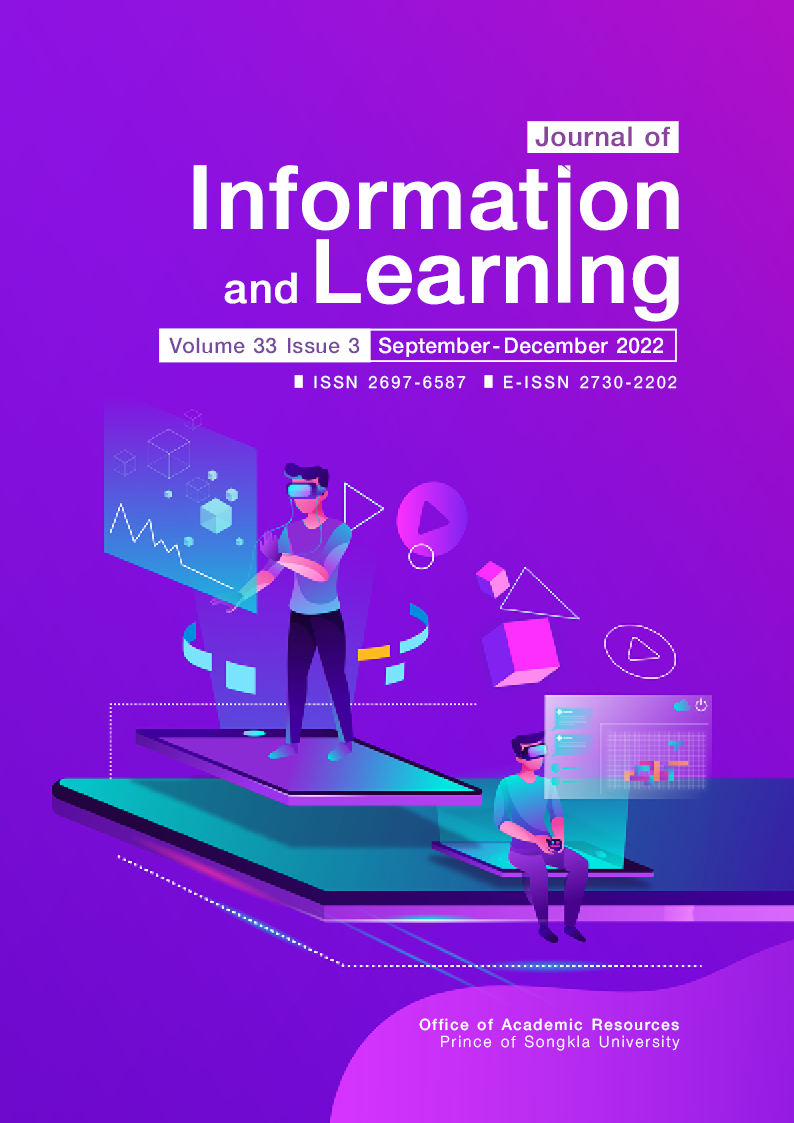The Development of a Mobile Application on Functions via Android Operating System for Grade 11 Students
Main Article Content
Abstract
The purposes of this research were 1) to develop a mobile application via Android operating system that enhances the mathematical problem-solving ability on Functions for grade 11 students in accordance with the criteria 70/70, and 2) to examine students' satisfaction towards using the developed mobile application. The sample group was grade 11 students who had learned about Functions at Roong Aroon School and had a score less than 60%. The research instruments consisted of tools for enhancing the mathematical problem-solving ability, tools for measuring and evaluating the mathematical problem-solving ability, and tools for measuring students' satisfaction towards using the mobile application via Android operating system. The results of this research showed that 1) the efficiency of the mobile application was 78.04/73.98, which was higher than the criteria, and that 2) the average satisfaction towards the mobile application was at very satisfied level (=3.96, S.D.=0.68). The proposed application that a researcher developed would be an alternative way that can be used to develop students’ mathematical problem-solving skills in conjunction with the teaching of the mathematics subject on Functions.
Article Details

This work is licensed under a Creative Commons Attribution-NonCommercial-NoDerivatives 4.0 International License.
The Journal of Information and Learning is operated by the Office of Academic Resources, Prince of Songkla University. All articles published in the journal are protected by Thailand copyright law. This copyright covers the exclusive rights to share, reproduce and distribute the article, including in electronic forms, reprints, translations, photographic reproductions, or similar. Authors own copyrights in the works they have created as well as the Office of Academic Resources. The Journal reserves the right to edit the language of papers accepted for publication for clarity and correctness, as well as to make formal changes to ensure compliance with the journal's guidelines. All authors must take public responsibility for the content of their paper.
References
BBC NEWS THAILAND. (2017, April 14). Prathēt thī kānsưksā dī thīsut nai lōk sip ʻandap [The ten best educated countries in the world]. BBC. https://www.bbc.com/thai/international-39599359
Best, J. W. (1977). Research in education. Prentice Hall. Boonrod, V. (2020). The development of the application for basic chord aural skill practice for undergraduate students. Journal of Education Naresuan University, 22(1), 204-219. https://so06.tci-thaijo.org/index.php/edujournal_nu/article/view/194681/160628
Brahmawong, C. (2013). Developmental testing of media and instructional package. Journal of Silpakorn Educational Research, 5(1), 1-20. http://www4.educ.su.ac.th/2013/images/stories/081957-02.pdf
Chaiyaprom, P., Nantasri, W., & Phengsawat, W. (2019). Development of training curriculum to enchance problem-solving skills of Bannontae school students under Sakon Nakhon primary educational service area office 3. Journal of Roi Et Rajabhat University, 13(1), 69-78. https://so03.tci-thaijo.org/index.php/reru/article/view/185965/130885
Charles, R., Lester, F., & O’Daffer, P. (1987). How to evaluate progress in problem solving. The National Council of Teachers of Mathematics.
Hensberry, K. R., & Jacobbe, T. (2012). The effects of Polya’s heuristic and diary writing on children’s problem solving. Mathematics Education Research Journal, 24(1), 59-85. https://doi.org/10.1007/s13394-012-0034-7
The Institute for the Promotion of Teaching Science and Technology [IPST]. (2012). Thaksa læ krabūankān thāng khanittasāt [Mathematical skills and processes]. 3Q Media.
JobsDB by SEEK. (2014). Hā hētphon thammai nakphatthana lư̄ak Android [5 reasons why develipers choose Android]. JobsDB. https://th.jobsdb.com/th-th/articles/nakphatthana lư̄ak-android
Kaewsomtong, A., & Udomvech, A. (2017). The development of Android application for learning of the moment of force for secondary students. Journal of Thaksin, 20(3), 228-235. https://ph02.tci-thaijo.org/index.php/tsujournal/article/view/102163/79068
Krulik, S. (1980). Problem solving in school Mathematics: Yearbook of the national council of teacher of Mathematics. NCTM.
Maneenin, A., Niramol, K., & Topithak, K. (2016). The development of mobile application in mathematics for computer subject about base number system for second year students of vocational certificate majoring in business computer. Journal of Faculty of Education Pibulsongkram Rajabhat University, 3(1), 22-33. https://doi.org/10.14456/edupsru.2016.3
Maslow, A. H. (1970). Motivation and personality (2nd edition). Harper & Row.
Pejchang, T., & Suksern, S. (2015, July 23). The development of mathematics achievement on probability for Mattayom 5 students by the Polya process [Paper presentation]. National and International Conference on Interdisciplinary Research for Sustainable Community 15th, Nakhon Sawan, Thailand.
Polya, G. (1957). How to solve it. Princeton. Princeton University Press.
Samnakngān khana kammakān kānsưksā hǣng chāt. (2017). Māttrathān kānrīanrū læ tūa chī wat (chabap prapprung Phō̜.Sō̜. 2560) tām laksūt kǣn klāng kānsưksā naphư̄n thān Phutthasakkarāt 2551 [Learning standards and indicators (revised edition 2017) according to the core curriculum of basic education 2008]. Prime Minister’s Office.
Samnakngān khana kammakān kānsưksā naphư̄n thān. (2019). Phrarātchabanyat kānsưksā hǣng chāt Phō̜.Sō̜. 2542 kǣkhaiphœ̄mtœ̄m chabap thī 2 Phō̜.Sō̜. 2545 chabap thī 3 Phō̜.Sō̜. 2553 læ chabap thī 4 Phō̜.Sō̜. 2562 [National education act, 1999, edition 2, 2002, edition 3, 2010, and edition 4, 2019]. Prime Minister’s Office.
Semertzidis, K. (2013). Mobile application development to enhance higher education lectures [Unpublished master's thesis, The University of York]. https://www.cs.uoi.gr/~ksemer/docs/theses/msc-ksemer.pdf
Sukbanjong, J. (2016). Khwāmrū thūapai kīeokap ʻǣp phlikhēchan [General Knowledge about Application]. Jiranun Sukbunjong. https://sites.google.com/site/jiranunsuk571031217/khwam-ru-thawpi-keiyw-kab-exeph-phli-khechan
Sukoriyanto, S., Nusantara, T., Subanji, S., & Chandra, T. D. (2016). Students’s errors in solving the permutation and combination problems based on problem solving steps of Polya. International Education Studies, 9(2), 11-16. http://doi.org/10.5539/ies.v9n2p11
Sungcharaen, K. (2013). Khūmư̄ khīan iPhone Apps samrap phū rœ̄mton [Guidebook to write iPhone Apps for Beginner]. Pro-Vision.
Suwannaparsop, C. (2018). The development of VDO interaction web applications for learning for undergraduate students, Srinakharinwirot University [Master’s thesis]. DSpace at Srinakharinwirot University. http://ir-ithesis.swu.ac.th/dspace/bitstream/123456789/350/1/gs571130115.pdf
Thailand Creative & Design Center [TCDC]. (2017). Kān khit chœ̄ng ʻō̜kbǣp: Rīanrū dūai kān longmư̄ tham [Design thinking: Learning by doing]. TCDC resource center. http://resource.tcdc.or.th/ebook/Design.Thingking.Learning.by.Doing.pdf
Witchavut, S. (2011). Čhittawitthayā kānrīanrū [Psychology of learning]. Thammasat University.
Yayuk, E., & Hussamah, H. (2020). The difficulties of prospective elementary school teachers in item problem solving for Mathematics: Polya’s steps. Journal for the Education of Gifted Young Scientists, 8(1), 361-378. https://doi.org/10.17478/jegys.665833


